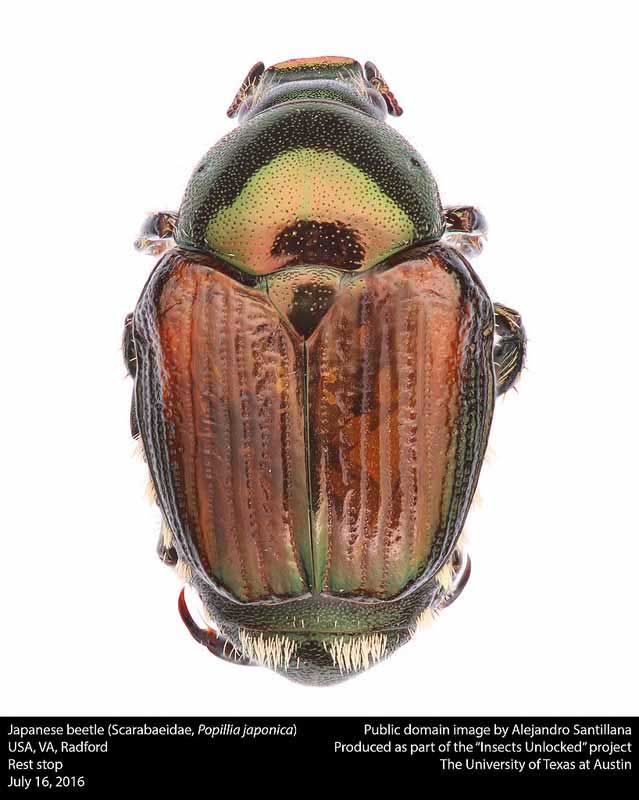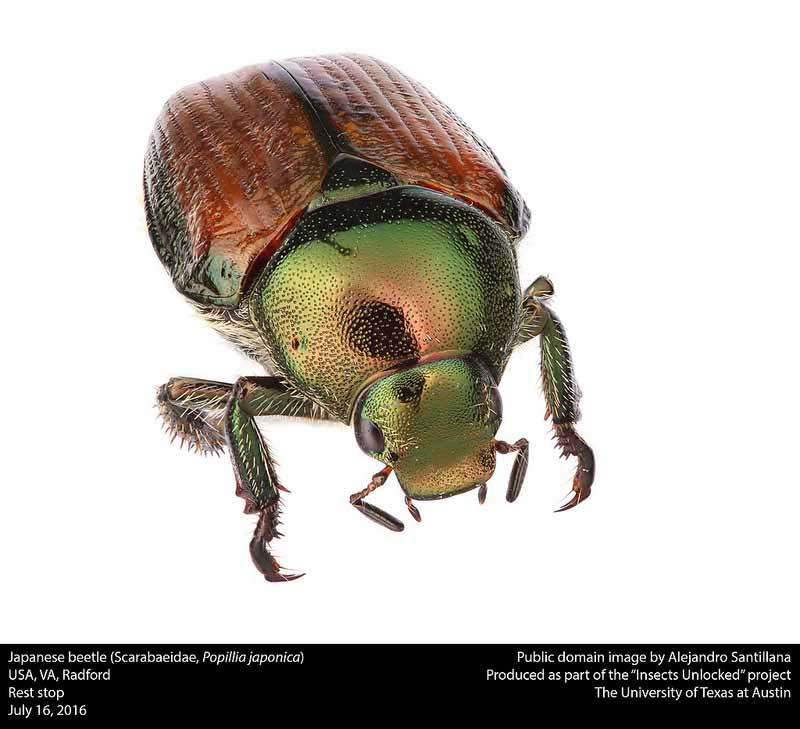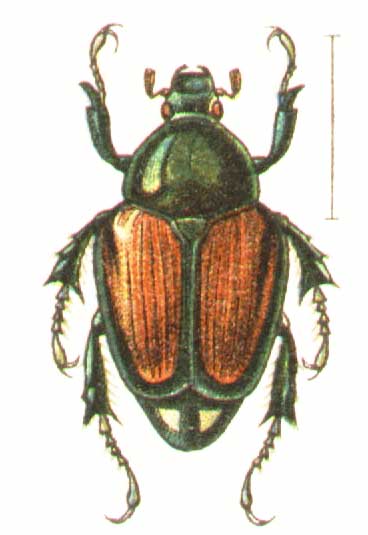
Popillia japonica
Superregnum: Eukaryota
Cladus: Unikonta
Cladus: Opisthokonta
Cladus: Holozoa
Regnum: Animalia
Subregnum: Eumetazoa
Cladus: Bilateria
Cladus: Nephrozoa
Cladus: Protostomia
Cladus: Ecdysozoa
Cladus: Panarthropoda
Phylum: Arthropoda
Subphylum: Hexapoda
Classis: Insecta
Cladus: Dicondylia
Subclassis: Pterygota
Cladus: Metapterygota
Infraclassis: Neoptera
Cladus: Eumetabola
Cladus: Endopterygota
Superordo: Coleopterida
Ordo: Coleoptera
Subordo: Polyphaga
Infraordo: Scarabaeiformia
Superfamilia: Scarabaeoidea
Familia: Scarabaeidae
Subfamilia: Rutelinae
Tribus: Anomalini
Genus: Popillia
Species: Popillia japonica
Name
Popillia japonica Newman, 1838


References
Popillia japonica Newman, 1838
Vernacular names
English: Japanese Beetle
Nederlands: Japanse kever
português: Besouro-japonês
русский: Японский жук
The Japanese beetle (Popillia japonica) is a species of scarab beetle. The adult measures 15 mm (0.6 in) in length and 10 mm (0.4 in) in width, has iridescent copper-colored elytra and a green thorax and head. It is not very destructive in Japan, where it is controlled by natural predators, but in North America, and partially in Europe, it is a noted pest of about 300 species of plants including rose bushes, grapes, hops, canna, crape myrtles, birch trees, linden trees, and others.
The adult beetles damage plants by skeletonizing the foliage, that is, consuming only the leaf material between the veins, and may also feed on fruit on the plants if present, while the subterranean larvae feed on the roots of grasses.
Description
Adult P. japonica measure 15 mm (0.6 in) in length and 10 mm (0.4 in) in width, with iridescent copper-colored elytra and green thorax and head. A row of white tufts (spots) of hair project from under the wing covers on each side of the body.[1]
Distribution
Popillia japonica is native to Japan, but is an invasive species in North America and in Europe.
The first written evidence of the insect appearing within the United States was in 1916 in a nursery near Riverton, New Jersey.[2] The beetle larvae are thought to have entered the United States in a shipment of iris bulbs prior to 1912, when inspections of commodities entering the country began. As of 2015, only nine western US states were considered free of Japanese beetles.[3] Beetles have been detected in airports on the west coast of the United States since the 1940s.
As of 19 July 2013 Japanese beetles had not been found in Wyoming,[4][5] however on August 17, 2020 the first finds were made in Wyoming, specifically at Kendrick Park in Sheridan.[6]
The first Japanese beetle found in Canada was in a tourist's car at Yarmouth, arriving in Nova Scotia by ferry from Maine in 1939. During the same year, three additional adults were captured at Yarmouth and three at Lacolle in southern Quebec.[7]
Japanese beetles have been found in the islands of the Azores since the 1970s.[8] In 2014, the first population in mainland Europe was discovered near Milan in Italy.[9][10] In 2017, the pest was detected in Switzerland, most likely having spread over the border from Italy. Swiss authorities are attempting to eradicate the pest.[11]
Only three were found in Washington State, USA in 2020, but then from late June to September 3, 2021 there were over 20,000 found in Grandview alone.[12]
Lifecycle
Lifecycle of the Japanese beetle. Larvae feed on roots underground, while adults feed on leaves and stems.
A typical cluster of Japanese beetle eggs
A Japanese beetle pupa shortly after moulting
Ova are laid individually, or in small clusters near the soil surface.[13] Within approximately two weeks, the ova hatch, the larvae feeding on fine roots and other organic material. As the larvae mature, they become c-shaped grubs which consume progressively coarser roots and may do economic damage to pasture and turf at this time.
Larvae hibernate in small cells in the soil, emerging in the spring when soil temperatures rise again.[13] Within 4–6 weeks of breaking hibernation, the larvae will pupate. Most of the beetle's life is spent as a larva, with only 30–45 days spent as an imago. Adults feed on leaf material above ground, using pheromones to attract other beetles and overwhelm plants, skeletonizing leaves from the top of the plant downward. The aggregation of beetles will alternate daily between mating, feeding, and ovipositing. An adult female may lay as many as 40–60 ova in her lifetime.[13]
Throughout the majority of the Japanese beetle's range, its lifecycle takes one full year, however in the extreme northern parts of its range, as well as high altitude zones as found in its native Japan, development may take two years.[14]
Control
Map showing the parts of the US infested by Japanese beetles, as of November 2006: They were present in many more sites as of July 2012.
Egg of biocontrol, tachinid fly Istocheta aldrichi, introduced from Japan
Phenological models might be useful in predicting the timing of presence of larvae or adults of the Japanese beetle. Model outputs can be used to support the timely implementation of monitoring and control actions against the pest, thus reducing its potential impact.[15][16]
Owing to its destructive nature, traps have been invented specifically to target Japanese beetles. These comprise a pair of crossed walls with a bag or plastic container underneath and are baited with floral scent, pheromone, or both. However, studies conducted at the University of Kentucky and Eastern Illinois University suggest beetles attracted to traps frequently do not end up in the traps, instead, they land on plants in the vicinity and cause more damage along the flight path and near the trap than may have occurred if the trap were not present.[17][18]
During the larval stage, the Japanese beetle lives in lawns and other grasslands, where it eats the roots of grasses. During that stage, it is susceptible to a fatal disease called milky spore disease, caused by a bacterium called milky spore, Paenibacillus (formerly Bacillus) popilliae. The USDA developed this biological control and it is commercially available in powder form for application to lawn areas. Standard applications (low density across a broad area) take from one to five years to establish maximal protection against larval survival (depending on the climate), expanding through the soil through repeated rounds of infection.
On field crops such as squash, floating row covers can be used to exclude the beetles, but this may necessitate hand pollination of flowers. Kaolin sprays can also be used as barriers.
Research performed by many US extension service branches has shown pheromone traps attract more beetles than they catch.[19][20] Traps are most effective when spread out over an entire community, and downwind and at the borders (i.e., as far away as possible, particularly upwind), of managed property containing plants being protected.
When present in small numbers, the beetles may be manually controlled using a soap-water spray mixture, shaking a plant in the morning hours and disposing of the fallen beetles,[20] or simply picking them off attractions such as rose flowers, since the presence of beetles attracts more beetles to that plant.[21]
Several insect predators and parasitoids have been introduced to the United States for biocontrol. Two of them, Istocheta aldrichi and Tiphia vernalis, are well established with significant but variable rates of parasitism.[22][23]
Hostplants
While the larvae of Japanese beetles feed on the roots of many genera of grasses, the adults consume the leaves of a much wider range of hosts, including these common crops:[7] bean, cannabis, strawberry, tomato, pepper, grape, hop, rose, cherry, plum, pear, peach, raspberry, blackberry, corn, pea, okra, and blueberry.
List of adult beetle hostplant genera
Abelmoschus
Acer (maple)
Aesculus (horse chestnut)
Alcea
Aronia
Asimina (pawpaw)
Asparagus
Aster
Buddleja
Calluna
Caladium
Canna
Cannabis sativa
Chaenomeles
Castanea (sweet chestnut)
Cirsium (thistle)
Cosmos
Dahlia
Daucus (carrot)
Dendranthema
Digitalis
Dolichos
Echinacea (coneflower)
Hemerocallis
Heuchera
Hibiscus
Humulus (hop)
Hydrangea
Ilex (holly)
Impatiens
Ipomoea (morning glory)
Iris
Juglans (walnut)
Lagerstroemia
Liatris
Ligustrum (privet)
Malus (apple, crabapple)
Malva (mallow)
Mentha (mint)
Myrica
Ocimum (basil)
Oenothera (evening primrose)
Parthenocissus
Phaseolus
Phlox
Physocarpus
Pistacia
Platanus (plane)
Polygonum (Japanese knotweed)
Populus (poplar)
Prunus (plum, peach)
Quercus (oak)
Ribes (gooseberry, currants, etc.)
Rheum
Rhododendron
Rosa (rose)
Rubus (raspberry, blackberry, etc.)
Salix (willows)
Sambucus (elder)
Sassafras
Solanum (nightshades, including potato, tomato, eggplant)
Spinacia (spinach)
Syringa (lilac)
Thuja (arborvitae)
Tilia (basswood, linden, UK: lime)
Toxicodendron (poison oak, poison ivy, sumac)
Ulmus (elm)
Vaccinium (blueberry)
Viburnum
Vitis (grape)
Weigelia
Wisteria
Zea
Zinnia
References
M.F. Potter; D.A. Potter; L.H. Townsend (January 2006). "Japanese Beetles in the Urban Landscape". University of Kentucky, College of Agriculture.
"Japanese Beetle Ravages". Reading Eagle. p. 26. 22 July 1923. Retrieved 28 September 2015.
"Managing the Japanese Beetle: A Homeowner' s Handbook" (PDF). www.aphis.usda.gov. United States Department of Agriculture Animal and Plant Health Inspection Service. Retrieved 21 August 2018.
"2013 Wyoming Japanese Beetle (Popillia japonica ) Survey Summary" (PDF).
"Popillia japonica | WY Cooperative Agriculture Pest Survey | University of Wyoming".
"Japanese beetles found in Kendrick Park". 21 September 2020.
"Popillia Japonica (Japanese Beetle) – Fact Sheet". Canadian Food Inspection Agency. 19 February 2014. Archived from the original on 4 December 2010. Retrieved 28 September 2015.
Virgílio Vieira (2008). "The Japanese beetle Popillia japonica Newman, 1838 (Coleoptera: Scarabaeidae) in the Azores islands" (PDF). Boletín Sociedad Entomológica Aragonesa. 43: 450. S2CID 83531725. Retrieved 28 September 2015.
"First report of Popillia japonica in Italy". EPPO. Retrieved 28 September 2015.
"Popillia japonica Newman, 1841" (PDF) (in Italian). Assessorato Agricoltura, Caccia e Pesca, Regione Piemonte. Retrieved 28 September 2015.
"First report of Popillia japonica in Switzerland". EPPO. 2017. Retrieved 19 June 2018.
"Japanese beetle count passes 20,000". WSDA AgBriefs. 3 September 2021. Retrieved 2021-09-16.
Fleming, WE (1972). "Biology of the Japanese beetle". USDA Technical Bulletin. 1449.
ODA. "Or egon Department of Agriculture Insect Pest Prevention & Management Program Oregon.gov/ODA Rev: 3/ 30 /2017 2 Japanese Beetle Eradication Response Plan 2017" (PDF). www.oregon.gov/ODA/. Oregon Department of Agriculture. Retrieved 31 May 2017.
Gilioli, Gianni; Sperandio, Giorgio; Simonetto, Anna; Colturato, Michele; Battisti, Andrea; Mori, Nicola; Ciampitti, Mariangela; Cavagna, Beniamino; Bianchi, Alessandro; Gervasio, Paola (2021-09-20). "Modelling diapause termination and phenology of the Japanese beetle, Popillia japonica". Journal of Pest Science. doi:10.1007/s10340-021-01434-8. ISSN 1612-4766. S2CID 239147213.
RÉgniÈre, Jacques; Rabb, Robert L.; Stinner, R. E. (1981-06-01). "Popillia japonica: Simulation of Temperature-Dependent Development of the Immatures, and Prediction of Adult Emergence". Environmental Entomology. 10 (3): 290–296. doi:10.1093/ee/10.3.290. ISSN 1938-2936.
"Japanese Beetles in the Urban Landscape". University of Kentucky. Retrieved 28 September 2015.
Paul V. Switzer; Patrick C. Enstrom; Carissa A. Schoenick (2009). "Behavioral Explanations Underlying the Lack of Trap Effectiveness for Small-Scale Management of Japanese Beetles". Journal of Economic Entomology. 102 (3): 934–940. doi:10.1603/029.102.0311. PMID 19610405. S2CID 11509873.
"Managing the Japanese Beetle: A Homeowner's Handbook". U.S. Department of Agriculture, Animal and Plant Health Inspection Service. May 2015. Retrieved 28 September 2015.
"Japanese beetle control methods". Landscape America. Ohio City Productions, Inc. Retrieved 28 September 2015.
Jeff Gillman (18 March 2010). "Disney and Japanese Beetles". Washington State University. Archived from the original on 14 March 2012. Retrieved 28 September 2015.
Rogers, Michael E.; Potter, Daniel A. (2004-06-01). "Biology of Tiphia pygidialis (Hymenoptera: Tiphiidae), a Parasitoid of Masked Chafer (Coleoptera: Scarabaeidae) Grubs, with Notes on the Seasonal Occurrence of Tiphia vernalis in Kentucky". Environmental Entomology. 33 (3): 520–527. doi:10.1603/0046-225X-33.3.520. ISSN 0046-225X.
Shanovich, Hailey N; Ribeiro, Arthur Vieira; Koch, Robert L (2021-04-01). "Seasonal Abundance, Defoliation, and Parasitism of Japanese Beetle (Coleoptera: Scarabaeidae) in Two Apple Cultivars". Journal of Economic Entomology. 114 (2): 811–817. doi:10.1093/jee/toaa315. ISSN 0022-0493.
Retrieved from "http://en.wikipedia.org/"
All text is available under the terms of the GNU Free Documentation License

